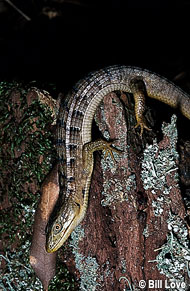Description:
Very similar to the northern alligator lizard to all aspects of its husbandry. The southern alligator lizard are active hunters that eat all kinds of insects, snails, and even baby mice in captivity. They thrive in moderate temperatures that vary between nighttime lows in the low 60s Fahrenheit to highs in the upper 80s during the day. A heat lamp on one end of the cage is important so the southern alligator lizards can bask when they feel it’s necessary to dry off or for digestion. Give them a cage with a woodland habitat – soil as substrate with scattered rocks and logs to crawl through and explore. They can be active day or night when temperatures are in the mid-range noted above. Crickets are a favored food item that they’ll dig up in the substrate if some escape at the initial feeding time, but care should be made that too many escaped insects build up in the cage because they may emerge to nibble on the lizard during cooler times. A small, shallow water bowl in a cage corner is recommended. Southern alligator lizards use their tails for balance and as a fifth leg when climbing. Add a rough-barked branch for them to exercise on and you’ll get to enjoy seeing them more active. Although that tail is fairly durable, in can break if the lizard is handled too carelessly. It’s best to support them by the body, never the tail alone.
Habitat:
Grasslands and open woodlands, often near creeks
Range:
West coast from southern British Colombia to Baja
Scientific Name: Elgaria multicarinata
Species Group:
Family: Anguidae
Size: Body 3 to 7 inches, with a tail that may more than double that length
Level: beginner
Weight:
Dangerous: No


